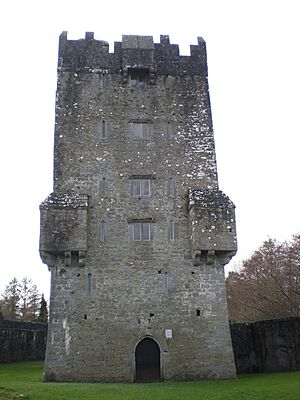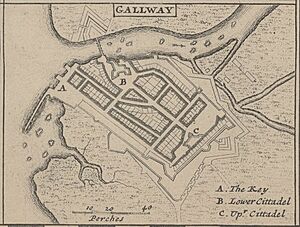History of Galway facts for kids
Galway, a cool city on the west coast of Ireland, has a really long and interesting history, going back about 800 years! It was the only big city in the province of Connacht during the Middle Ages.
Contents
What's in a Name? The Story of Galway
The city gets its name from the river it sits on, called the Gaillimh. This old Irish word means "stony," so it's like "the stony river." Today, most people call the river the River Corrib, because it flows from Lough Corrib (a big lake) just north of the city. In Irish, Galway is also known as Cathair na Gaillimhe, which means "city of Galway." This helps people know it's the city and not County Galway, which is often just called Gaillimh in Irish.
There are a few other stories about where the name came from:
- Some people used to think the name came from an Irish word meaning "foreigners," like "the town of the foreigners." But this isn't quite right, because the river was called Gaillimh first, and then the town got its name from the river.
- Another story says that a local leader's daughter, named Gailleamh, sadly drowned in the river. Her father was so sad that he set up camp by the river to remember her. Later, a town grew up there and was named Gaillimh in her honor.
Galway's Early Days

A fort called Dún Bhun na Gaillimhe (which means 'Fort at the Mouth of the Gaillimh') was built in 1124. It was a naval base and military fort, built by the King of Connacht, Tairrdelbach Ua Conchobair. This fort was attacked several times in the years that followed. The area where Galway is located was controlled by the O'Halloran clan, and later by the O'Flaherty clan, until the Norman invaders arrived in the 1230s.
In 1232, after a tough siege, the fort was captured by Richard Mor de Burgh. For the next hundred years, Galway grew and did well under the de Burgh family. But by 1333, the de Burgh family started having problems, and the people of Galway wanted to control their own city. They got permission from the King in 1396 to build a defensive wall around their town.
Galway was then run by a group of powerful merchant families, who became known as The Tribes of Galway. These families were mostly English-speaking and focused on trade. This made Galway quite different from the Gaelic (Irish-speaking) areas around it.
From Medieval Times to the 1500s

In December 1484, Galway officially became an independent town, free from the control of the Clanrickard Burkes. At the same time, the townspeople gained control of their main church, St. Nicholas' Collegiate Church.
During the Middle Ages, Galway was a very important trading city. It was managed by 14 rich merchant families, known as the Tribes of Galway. The city was the main Irish port for trading with Spain and France. It also traded a lot with the Western Isles of Scotland. About 3,000 people lived in medieval Galway.
A famous explorer, Christopher Columbus, even visited Galway in 1477! He might have been on a trip to Iceland or the Faroe Islands. Years later, he wrote in his notes that he saw "a man and a woman, of extraordinary appearance," who came ashore in Galway on some tree trunks. People think these might have been Inuit people who drifted across the ocean.
By the 1460s, Galway was known as a beautiful and well-built town. However, it often had problems with its Irish neighbors. A sign over the west gate of the city, put up in 1562, famously said: "From the Ferocious O'Flahertys may God protect us." There was even a rule in 1460 that said no one in Galway should sell land to an Irishman without special permission!
Despite these rules, the people of Galway started to adopt some Irish customs and language. In 1536, a law from King Henry VIII tried to make people in Galway more English. It said they had to shave their moustaches, let their hair grow to cover their ears, and wear English hats. It also said they shouldn't wear traditional Irish cloaks or the color saffron, which was popular with native Irish people. Most importantly, it told everyone to speak English and send their children to school to learn English.
Galway faced many challenges because of the political unrest in the area. In 1576, an English official noted that Galway was "much decayed" because of attacks from the sons of the Earl of Clanrickard. Many families had to leave the town.
Even so, Galway kept its unique look. In 1579, another official described Galway as a "well built, and walled" town with a great harbor and many wealthy merchants. He thought the people of Galway seemed more civilized than those in other Irish towns, comparing it to Dublin and Waterford.
The merchants of Galway were very careful because of the dangers of trade. Their new city rules said that when any foreign ships came to their port, they had to be searched for weapons. Also, no more than ten people from a ship were allowed into the town at a time.
Because Galway was loyal to the English Crown, it was sometimes used as an administrative center by the English authorities.
A Time of Trouble and Change

Galway faced a difficult time in the 1600s. After the Irish Rebellion of 1641, Galway was caught between the Catholic rebels (called the Confederates) and the English soldiers stationed outside the city. In 1642, the people of Galway, who were mostly Catholic, decided to support the Confederates. They helped besiege the English fort until the soldiers surrendered.
During the 1640s, Galway was heavily fortified, preparing for an attack from English forces. This attack came when English Parliamentarian forces, led by Oliver Cromwell, re-conquered Ireland between 1649 and 1652. Galway surrendered to Cromwell's forces in 1652 after a nine-month siege. This led to a terrible time for the city, with plague and many Catholic citizens being forced to leave. A law called the Act for the Settlement of Ireland 1652 caused huge changes, as people from other parts of Ireland were moved to Connacht.
After the English monarchy was restored in 1660, Galway's economy slowly started to get better. However, when King James II was removed from power in 1689, Galway supported him. The city surrendered in 1691 after a major battle nearby. After this, Galway became less important economically, and it took about 300 years for the city to become as important as it once was.
Galway in the 1700s

After the wars of the 1600s, Galway, as a Catholic port city, was viewed with great suspicion by the authorities. A law in 1704 said that no new Catholics, except for sailors and day laborers, could move to the city. If there were fears of a French invasion, all Catholics were ordered to leave Galway. The city's government was also only allowed to have Protestants. This was surprising because a census in 1762 showed that out of about 15,000 people in the town, only 350 were Protestants!
The tough treatment of Galway's old Catholic merchant families meant that trade dropped a lot, and the busy harbor fell into disrepair. Local traders tried to make up for this by smuggling goods like brandy through gaps in the town walls. On November 1, 1755, a huge earthquake in Lisbon, Portugal, caused a two-meter high tsunami to hit Galway's coast. It caused some serious damage to the "Spanish Arch" part of the city wall.
The 1800s in Galway
Galway's economy started to improve a bit in the late 1700s as some strict laws against Catholics were eased. However, the countryside around the city suffered terribly during the Great Irish Famine in the 1840s. Unlike other Irish cities that grew a lot during this time, Galway's population actually went down because of how devastating the famine was.
The second half of the 1800s brought some good changes to Galway. Railway lines reached the city in 1850, making travel and trade easier. Another important step was the creation of a university in Galway in 1845, which was then called "Queens University of Ireland".
Galway in the 1900s
Galway city played a smaller role in the big changes happening in Ireland from 1916 to 1923. In 1916, during the Easter Rising, a leader named Liam Mellows gathered local Irish Volunteers to attack a police barracks near Galway. They didn't succeed and later surrendered.
During the Irish War of Independence (1919–1921), Galway was the main base for the British Army in the west. Because the British had so many soldiers in the city, the local Irish Republican Army (IRA) couldn't do much against them. There was a lot of fear of attacks on civilians, especially after nearby towns were attacked by the Black and Tans. In November 1920, a Catholic priest from Galway, Fr. Michael Griffin, was taken and shot by British forces. His body was later found in a bog. Galway business people also started a boycott of goods from Northern Ireland to protest attacks on Catholics in Belfast.
Before the Irish Civil War (1922–1923) began, there was a tense situation in Galway in March 1922 between soldiers who supported the new Irish Free State and those who were against it. When fighting broke out in July 1922, the city and its military barracks were taken over by the National Army of the Irish Free State. Some soldiers were killed before the National Army secured the area. Before leaving Galway, the anti-treaty Republicans burned several public buildings in the city center.
On August 16, 1971, a part of the city center was destroyed by a big fire, near Eyre Square.
|

